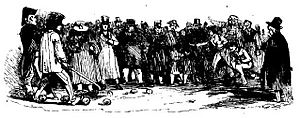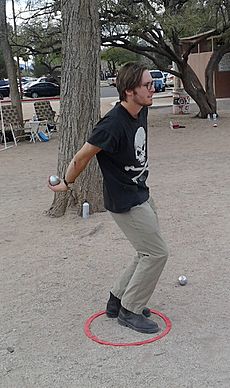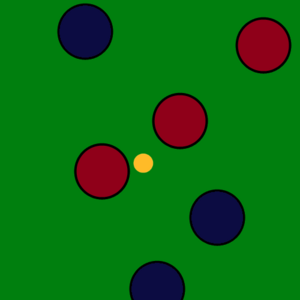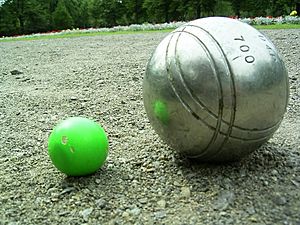Pétanque facts for kids

Pétanque players on the beach in Nice
|
|
| Highest governing body | Fédération Internationale de Pétanque et Jeu Provençal |
|---|---|
| First played | Provence, France |
| Characteristics | |
| Contact | Non-contact |
| Team members | Individual, doubles and triples |
| Type | Boules |
| Equipment | Boules (balls) & cochonnet (little ball) |
| Presence | |
| Olympic | No |
| World Games | 1985–present |
Pétanque is a fun sport where players throw metal balls called boules towards a small target ball. This target ball is known as a jack (or cochonnet in French). The goal is to get your boules closer to the jack than your opponent's boules. You can also hit your opponent's boules away from the jack. Players must stand inside a circle with both feet on the ground when throwing.
Pétanque is usually played on hard dirt or gravel. You can find games in public parks or special playing areas called boulodromes. This game is part of a bigger group of sports called boules sports.
The game we play today was created in 1907 or 1910 in La Ciotat, a town in Provence, France. The name pétanque comes from a French phrase meaning 'foot fixed' or 'foot planted' on the ground.
Contents
History of Pétanque
How the Game Began
Games played with boules have a very long history. They go back to ancient Rome, Greece, and even Egypt. In France, during the late 1800s, a game called jeu provençal was very popular. In this game, players would run three steps before throwing their boule.
Pétanque started in 1910 as a new version of jeu provençal. It happened in La Ciotat, near Marseilles. A player named Jules Lenoir had bad rheumatism. This made it hard for him to run before throwing. His friend, Ernest Pitiot, owned a café. To help Jules, Ernest created a new way to play. The playing area was made smaller, and players stood still in a circle to throw. They called this new game pieds tanqués, which means "feet planted." This name later became pétanque.
The first pétanque tournament was held in 1910 by Ernest Pitiot and his brother Joseph. The game quickly became very popular in France.
The Evolution of Boules
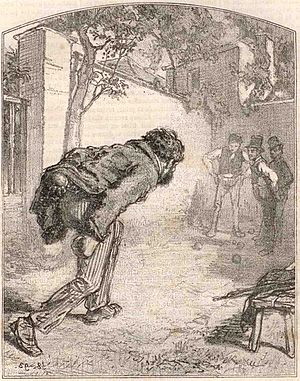
Before the mid-1800s, boules were made of solid wood. Later, people started covering wooden boules with nails. These were called boules cloutées ("nailed boules").
After World War I, a new way to make hollow, all-metal boules was invented. The first all-metal boule was called la Boule Intégrale. It was made from a bronze-aluminum mix. Soon after, Jean Blanc found a way to make steel boules by welding two metal halves together. This made hollow metal boules the standard.
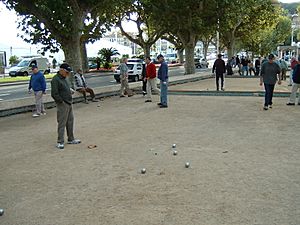
Pétanque Around the World
After metal boules were invented, pétanque quickly spread. It went from Provence to the rest of France, then to other parts of Europe. It also became popular in countries that used to be French colonies.
Today, many countries have their own pétanque groups. In France, over 300,000 people are official members of the Fédération Française de Pétanque et Jeu Provençal (FFPJP). The game is also popular in Germany, Spain, and England. You can find many pétanque players in Southeast Asia, like Laos, Thailand, and Vietnam. It's also big in Madagascar and parts of Africa.
Pétanque was part of the 2015 All-Africa Games. In the Americas, it's not as common, but Canada and the United States have pétanque groups. The main international group for pétanque is the Fédération Internationale de Pétanque et Jeu Provençal (FIPJP). It was started in 1958 and has almost 800,000 members worldwide.
Major Competitions

There are many important pétanque tournaments around the world. The FIPJP world championships happen every two years. Men's championships are in even years, and Women's and Youth championships are in odd years.
One of the most famous international events is the Mondial la Marseillaise à Pétanque. It takes place every year in Marseille, France. Over 10,000 players and 150,000 fans attend this huge event.
In the United States, the biggest yearly tournament is the Petanque Amelia Island Open in Florida. In England, the British Open attracts players from all over the UK and Europe.
Pétanque is not yet an Olympic sport. However, a group called the Confédération Mondiale des Sports de Boules has been trying to get it included since 1985. Pétanque has been featured in every World Games since 1985. The 2022 World Games in the United States included women's pétanque events.
How to Play Pétanque
These rules are based on the official rules from the Fédération Internationale de Pétanque & Jeu Provençal.
Equipment You Need
Pétanque is played by two teams. Each team can have one, two, or three players.
- In games with one or two players per team, each player uses three metal boules.
- In games with three players per team, each player uses two boules.
The playing area is called a terrain. You can play in open spaces like parks. For official games, the terrain might have marked boundaries, often with strings.
Players throw their boules while standing in a circle. This circle used to be just scratched in the dirt. Now, red plastic circles are often used in formal games. A drawn circle must be 35 to 50 cm wide. A plastic circle must be 50 cm wide inside.
Understanding the "Ends"
A game of pétanque is made up of several "ends" (called mènes).
- An end starts when the small wooden target ball, the jack (or cochonnet), is thrown out.
- Then, both teams throw their boules.
- After all boules are thrown, the team with the boule closest to the jack wins the end.
- The winning team gets one point for each of its boules that is closer to the jack than the other team's closest boule.
- A team can score up to six points in one end, but usually, they score one or two points.
- The game continues until one team reaches 13 points, which wins the game.
Order of Play
A coin toss decides which team starts the game. 1. The team that wins the toss places the circle on the ground. 2. A player from that team stands in the circle and throws the jack. The jack must land between 6 and 10 meters away. 3. Then, a player from the same team throws the first boule. 4. Next, a player from the other team throws a boule. 5. From then on, the team whose boule is not closest to the jack throws next. This team keeps throwing until one of their boules is closest, or they run out of boules.
If the closest boules from both teams are the same distance from the jack, the team that threw last throws again. If they are still tied, the teams take turns throwing until the tie is broken. If they are still tied at the end of the round, no team scores points.
The team that won the last end starts the next end. A player from that team places the circle around where the jack landed. They then pick up the jack, stand in the circle, and throw the jack to start the new end.
Scoring Points
An end finishes when all boules have been played, or if the jack is knocked out of play (goes "dead").
- If the jack is still in play and one team has the closest boule, that team wins the end. They score one point for each of their boules that is closer to the jack than the other team's closest boule.
- If the jack is in play but the closest boules are tied at the end, no team scores points.
- If the jack goes dead, and only one team still has boules left to throw, that team scores one point for each boule they still have. Otherwise, no team scores points.
Other Important Rules
- You can throw a boule in any way you like. The traditional way is to hold the boule with your palm down. Then, you swing your arm underhand and flick your wrist upwards. This makes the boule spin backward, giving you more control.
- You can roll the boule, throw it moderately high, or even throw it very high (a high lob or portée).
- Players often carry a tape measure to check which boule is closer.
- At the start of an end, if there isn't enough space to throw the jack the full 10 meters, you can move the circle back. This ensures there is enough room.
- On a marked terrain, a boule or jack must completely cross the boundary string to be considered out-of-bounds.
Equipment Details
Boules
Leisure boules are for casual games. They are cheaper and come in one standard size and weight. They are great for playing in your backyard.
Competition boules must follow strict rules set by the FIPJP. They must be hollow and made of metal, usually steel. Their size must be between 70.5 and 80 mm across. Their weight must be between 650 and 800 grams. When you buy competition boules, you can choose their size, weight, hardness, and the patterns on their surface.
The Jack
The jack, or target ball, is a small ball. It's made of wood, usually boxwood or beechwood. It is 30 mm across. Jacks used to be plain wood, but now they are often painted in bright colors. In French, the jack has many names, like but, cochonnet, bouchon, le petit, and gari.
Playing Area
Pétanque can be played on almost any flat, open space. The ground can be uneven, with rough and smooth spots. When a special area is built for pétanque, it usually has loose gravel, crushed stone, or crushed shells. Sandy beaches are not good for pétanque, but you can use light plastic boules there. There are no walls needed around the playing area, but special pétanque courts often have low borders.
In France, village squares and park paths are often used for pétanque. Many towns also have special facilities called boulodromes built just for the game.
A single pétanque game is played on a terrain. A larger "playing area" (aire de jeu) can hold many terrains. For tournaments, a big playing area is divided into rectangular marked terrains (also called "lanes"). These lanes are at least 4 meters wide and 15 meters long.
Game Strategy
Pointing and Shooting
When you throw a boule, you usually have one of two main goals:
- Pointing: This means trying to make your boule land as close as possible to the jack.
- Shooting: This means throwing your boule to directly hit an opponent's boule. The goal is to knock it away from the jack.
The best shot is called a carreau. This is when you hit an opponent's boule away and your own boule lands exactly in its place.
Players who are good at shooting are called 'shooters' (tireurs). Players who are good at pointing are called 'pointers' (pointeurs). Usually, pointers play first. Shooters are kept ready in case the other team places their boules well. Good pointing helps you score points. However, in big championships, skilled shooters often win by knocking away the opponent's best boules.
Tips for Throwing a Boule
Here are some things to think about when throwing a boule:
- A common saying is boule devant, boule d'argent ("A ball in front is a money ball."). This means a boule that lands in front of the jack is very valuable. It blocks the other team from throwing directly at the jack. If it gets hit, it might even move closer to the jack.
- If you point a boule very close to the jack, it might force the other team's shooter to try and hit it right away. This can be good if you want them to use up their boules.
- It's usually not a good idea to shoot with your team's last boule. It's often better to just point it close enough to the jack. This way, you limit the other team to only scoring one point.
Tips for Throwing the Jack
Here are some ideas for where to throw the jack:
- Throw the jack to a distance where your own shooter feels most comfortable. Or, throw it to a distance where the other team's shooter feels least comfortable.
- Aim for a spot on the terrain that your pointers like. Or, choose a spot that might be hard for the other team's pointers.
- Keep the other team guessing! Don't always throw the jack to the same spot. Change it up, throwing it sometimes long and sometimes short.
Pétanque Terms
Here are some special words used in pétanque:
- Bombard: To hit an opponent's boules one after another, especially after they have taken the lead.
- Boule devant, boule d'argent: A French saying meaning "A ball in front is a money ball." It reminds players that a boule in front of the jack is very valuable.
- Carreau: (pronounced carrow) This is the perfect shot. You hit an opponent's boule away from the jack, and your own boule lands exactly in its place.
- Circle (cercle or rond): The marked area where players stand to throw their boules.
- End (mène): A round of play. It starts when the jack is thrown and ends when all boules are played.
- Fanny (mettre fanny): To lose a game without scoring any points (13 to 0). If a team loses this way, they are said to be "fanny." In some places, the losing team has to buy drinks for the winners. There's often a picture or statue of a bare-bottomed girl named Fanny.
- Have the point: A team "has the point" if one of their boules is closer to the jack than any of the other team's boules. The team that does not have the point throws next.
- Jack (but, also cochonnet, petit): The small wooden or plastic target ball.
- Lob (portée): A boule thrown high in the air. It lands and rolls only a short distance.
- Point: To throw your boule so it stops very close to the jack. This is also called placing.
- Shoot: To throw your boule at an opponent's boule or at the jack. The goal is to knock it out of play.
Images for kids
-
Playing pétanque in the late afternoon at Aigues-Mortes
-
Men playing pétanque next to the Fort St. Louis in Toulon.
-
The 2006 Pétanque World Championship in Grenoble, France
-
Players of the Brighton & Hove Petanque Club on the Peace Statue Terrain, Brighton & Hove, UK
-
Pétanque is a popular game among pensioners, here in Ystad 2022.
See also
 In Spanish: Petanca para niños
In Spanish: Petanca para niños


